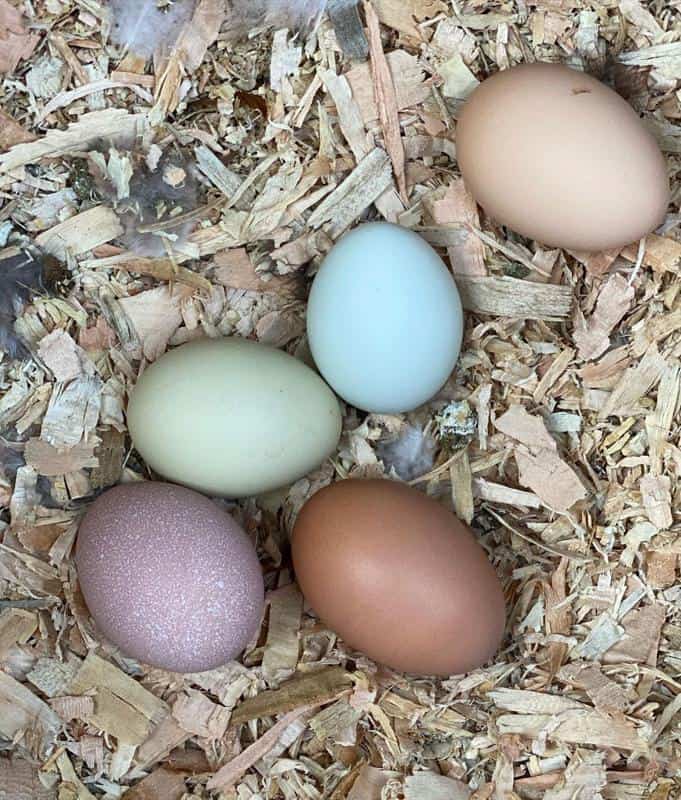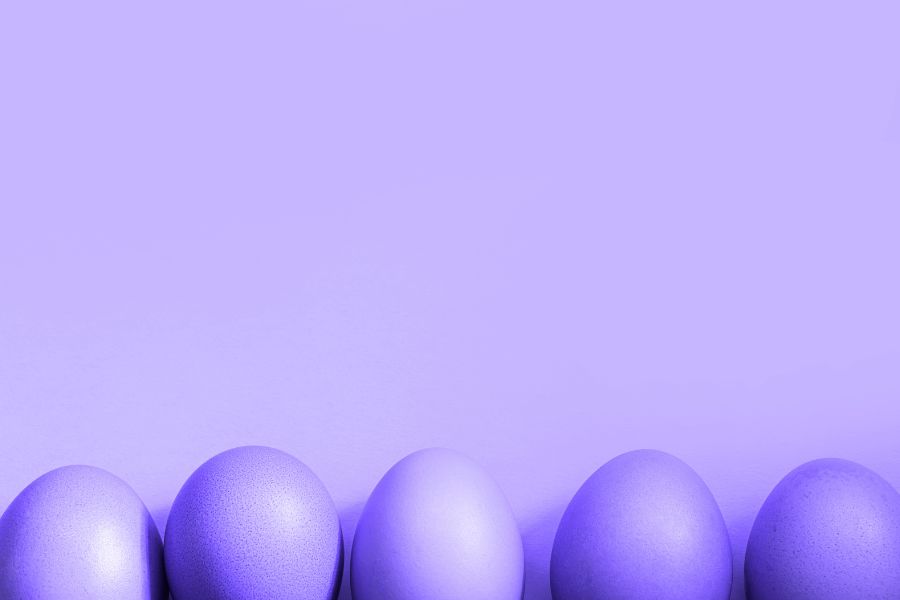You may have stumbled upon a video clip where a chicken keeper proudly showcases the uniquely-colored purple eggs from their flock. Or, you could be a great lover of uniquely colored eggs and want to know whether there’s a particular breed that can give you distinct purple-hued eggs.
Either way, purple eggs are cute to behold, and we’d all relish having them form part of our egg cartons. But then, with great admiration for them emerges one question — what chickens lay purple eggs?
In this article, we’ve compiled all the information you should know regarding chicken breeds that produce purple eggs.
What Chicken Lays Purple Eggs?
Unfortunately, as of now, there isn’t any chicken breed producing genuinely purple eggs. Usually, the purple hue occasionally seen in some eggs results from the hen’s bloom and isn’t the inherent color of the eggs.
Ordinarily, eggs come in white or brown. Exceptions, however, still exist. Green, blue, cream, and pig pigmentation (or should we humorously term it pinkmentation) are notable examples of the unusual color of eggs.
It doesn’t end there, though, as eggs can still come in purple. However, unlike most other egg colors, the purple hue has more to do with the bloom than anything else. In fact, as widely observed, the purple pigmentation is easy to wash off with water.
So, What Is Egg Bloom?
Bloom, technically called the egg cuticle, is a protein layer covering an egg’s surface. The thin film keeps the egg fresh for longer and prevents the intrusion of air and bacteria through its pores.
The protective layer works by filling the egg pores (estimated to be about 7,000 in every egg), altering the original color of the eggshell, and creating a purple visual effect in the process.
Bloom formation marks the last step of the egg-formation process, happening 30 to 60 minutes before the egg is laid. The thin film emerges wet, sticky, and clear, allowing you to see the original color of the eggshell. But as it dries out, it gains the purple hue.
However, until it dries out, the egg remains susceptible to bacteria and other contaminants, underscoring the significance of maintaining a clean nesting box.
Surprisingly, despite the layer’s purple effect on an egg, egg bloom isn’t always purple. It can be reddish or pinkish, with the purple impact emanating from the interaction of either of these colors with the eggshell’s brown or cream color.
That’s to say, purple eggs are usually associated with chickens producing brown or cream-colored eggs. If the color of the eggshell is white, the bloom will rather form a pink tint.
But then, it’s worth noting that not all eggs will have a bloom. As such, purple eggs only happen occasionally, so don’t be surprised when your chicken goes back to her normal color of eggs the next day after she lays a purple egg.
The Color of The Eggshell Plays a Main Role

The color of the eggshell is an essential factor in determining the possibility of a chicken producing purple eggs. Hence, you should work with chickens having specific egg colors to increase the probability of getting purple eggs from your flock.
Usually, chicken keepers rely on the color of the earlobes to predict what hue of eggs a chicken can lay. According to this rule, white or light earlobes indicate white eggs, while red or dark earlobes denote that a chicken will produce brown-shelled eggs.
How that works so isn’t explicitly clear, but it’s believed that the gene responsible for determining the color of eggs is the same one that defines what color of earlobes the chicken should have.
But, of course, as with most rules, there are exemptions. In some cases, the earlobe color may differ from the shade of eggs, explicitly challenging the correlation. A case in point is the Cream Legbars. Although these chickens typically have white or cream earlobes, they lay eggs with a light blue or green hue.
Another notable example is Araucana chickens. Despite their usual red earlobes, these chickens have a variety of possible egg shades, from blue and green to pink and lavender, clearly defying the rule.
Genetics remains the only ultimate determinant of an egg’s color. Genetic factors define the color of an egg by intricately controlling one critical element — the color of the eggshells.
The eggshell color is a product of three pigments — biliverdin, which produces the blue shade of eggs; protoporphyrin, responsible for brown, yellow, and red color; and zinc-biliverdin chelate, which gives eggs green pigmentation.
Each of these pigments is secreted during egg formation as the egg traverses the hen’s reproductive tract. But they’re not secreted in equal amounts, with the most dominant pigment, as governed by genetics, dictating the final color of the eggshell.
To get eggs with brown eggshells, the pigment responsible, protoporphyrin, has to be the most dominant of the three. The same applies to other egg pigments — biliverdin for blue and zinc-biliverdin chelate for green eggshell.
Chicken Breeds More Likely to Produce Purple Eggs

Only chickens producing brown or cream-shelled eggs will likely give you the purple hue. And usually, it’s worth noting that the intensity of the purple tint tends to amplify with ricker eggshell colors.
Here are some of the breeds more often associated with purple eggs:
1. Marans
Maran chickens tend to be more frequent layers of purple-tinted eggs than most other breeds possessing the capability.
Purple eggs will still happen sporadically, however, so expect the breed’s usually dark brown eggs (think chocolate-brown) most of the time. The overall egg count can stretch to anywhere between 150 and 200 annually.
2. Buff Orpingtons
Forget about the generally sweet disposition of these gentle giants, Buff Orpingtons are dual-purpose birds that will occasionally skip their usual large brown-shelled eggs to give you the much coveted purple-tinged eggs without stealing away the original egg size. They are proficient layers capable of delivering up to 280 eggs per year.
3. Easter Eggers
Easter eggers will produce a wide assortment of egg colors, with each chicken sticking to a single egg color throughout its entire life.
If you have one producing dark brown eggs, there’s the probability of collecting purple eggs from the nesting box from time to time. The annual egg count of Easter Eggers can hit the 250-mark, but this may vary from bird to bird.
4. Red Stars
The Redstar chicken is a dual-purpose breed mostly kept for their high proficiency in egg production. With this chicken, you can expect about 360 large eggs per year. The color of the egg is typically brown, but like the predecessors, don’t be surprised when they occasionally gift you purple eggs, thanks to their thick bloom.
5. Croad Langshan
Croad Langshan is yet another versatile breed with excellent laying capabilities. Expect about 140 to 150 large brownish eggs per year. Occasionally, the eggs have a pink or lavender bloom over them, but at times they produce thick plum blooms that create a purplish color effect.
Is It Possible For A Chicken To Lay Different Colors Of Eggs?
No, the color of your chickens’ eggs is tied to the breed and won’t change with time.
Let’s assume that you get a White Leghorn chicken. This breed is known to produce white eggs, and this phenomenon cuts across all White Leghorn chickens.
Your White Leghorn chicken will always lay white eggs. This color won’t change with age, climate, or nutrition, although the eggshell’s thickness and the yoke’s color may, depending on the diet, environmental conditions, and other factors.
But again, as with the earlobe rule, it’s worth noting that the single-egg-color-per-breed doesn’t apply to all chickens.
Some breeds, like Easter Eggers, exhibit a wide range of egg colors within the same breed. That means if you have three Easter Eggers in your flock, don’t be surprised when you get different egg colors.
But again, the rule that an individual chicken’s egg color remains consistent still applies hear. So, if you get an Easter Egger wired for pink eggs, you should always expect pink eggs from her and not any other color at any given time.
Do Purple Colored Eggs Taste Different?
While purple eggs may provide a better visual appeal than most other egg colors, they’re not in any way more superior in taste than any other color of eggs from the rest of the flock, as long as all the chickens are on the same diet.
As already pointed out, the purple hue is a makeup for the egg and will easily come off upon wetting the egg’s exterior. It doesn’t denote that the egg comes with a distinct nutritional component.
So, as long as your flock is healthy and feeding the same type of food, expect a uniform taste of the eggs despite the wide assortment of egg colors you may get.
Read More:
Final Verdict
We don’t have a specific chicken breed that produces true purple eggs. The purple shade seen on some eggs isn’t the actual color of the eggs. Instead, it’s waxy coating called the bloom or the egg cuticle.
The coating shields the egg from bacteria and other threats and is usually associated with chickens producing brown and cream-colored eggs. However, it’s a temporary film that will come out easily when you wash the egg, exposing the eggshell’s original brown or cream color.

